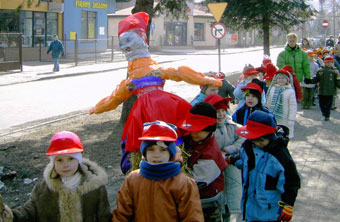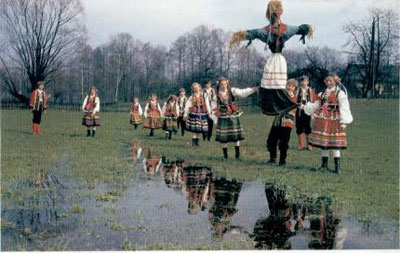Human Flower Project
Tuesday, March 21, 2006
‘Here You Go,’ Marzanna
In Silesia, the old straw-lady of winter must be flung out so that spring can flower.

Preschoolers in Poland, with Marzanna
Photo: Przedszkole Samorzadowe
By the almanac, there are days for killing as well as for planting, feeding, and watering. If the moon never swept through the fire signs (Aries, Leo, Sagittarius), we’d be overrun with weeds.
In that spirit across Silesia, as Aries enters—March 21—it’s time to drown Marzanna, the frost queen. She’s winter’s witch from the pantheon of pagan Slavic deities. And her time is up.
On March 21, people in this part of Central Europe traditionally make an effigy “with the last straw of last years’ harvest, dressed in white with a broom and cycle. She is decorated with ribbons, myrtle, or woodruff” (Asperula orodtata) and “carried in a procession of the people to a river. They burned and drowned her to rid themselves of the cold, dark season of death to welcome the spring.”
While today people may not actually use straw from the last harvest, in Southern Poland, parts of the Czech Republic and Slovakia, this is still a rite of Spring. In Slovakia, the tradition was formerly observed by older women but began to fade out in the 1930s. Ethnographer Elena Benusova writes that it was teenagers who revived the custom—“Girls that used to get together for spinning.” They would parade the Marzanna (called “Morena” in the Orava region) around the village singing, then going into the fields to plant flax.

Marzanna in the fields, Poland
Photo: Topienie Marzanny
“That is where they would dance with Morena and jump high. In other villages they would sprinkle the straw from the figure over the fields. This way they wanted to assure rich and beautiful harvest of tall flax.” The weavers would strip the cloth off Marzanna and either burn her wooden skeleton or throw it in the stream, yelling, “Here you go, you witch!”
Well, okay!
In another source, we find “As the marzanna was carried out of the village one way, on the opposite side the villagers carried in the maik – green branches adorned with ribbons, coral beads and flowers.” While we’ve found a number of pictures of Marzanna on her way out of town, we can’t find any of the maik coming in.
Silesian readers, should we be lucky enough to have any, please inform us. Might the Maik be one and the same as Gaik, a fir twig also decorated in the spring?
Treat yourself to this marvelous Marzanna photo-essay. It shows a preschool class in Poland transporting their doll-witch down to the local river and tossing her in. Ploop. We find especially enchanting the photo of their classroom. Look at all the plants, flowers and greenery! Kudos to both teacher and students for creating such a lively environment for learning.
This being 2006, the Marzanna custom might seen arcane or romantic. We don’t think so. Rather it calls to mind what “biology-watcher” Lewis Thomas observed, so wisely: “Everything that comes alive seems to be in trade for something that dies.”
Killing off Marzanna is a trade. Make room! Children are growing, and fresh flowers are coming on.




